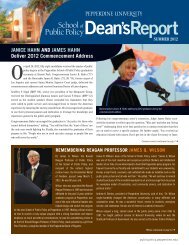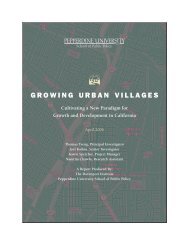Finding Permanent Homes for Adoptable Children - Pepperdine ...
Finding Permanent Homes for Adoptable Children - Pepperdine ...
Finding Permanent Homes for Adoptable Children - Pepperdine ...
You also want an ePaper? Increase the reach of your titles
YUMPU automatically turns print PDFs into web optimized ePapers that Google loves.
Chapter 1. An Introduction to Interstate Placement<br />
Every child deserves to grow up in a loving and safe environment, yet <strong>for</strong> many children in the United<br />
States, such a childhood is never a reality. In the year 2000, 131,000 children nationwide waited <strong>for</strong><br />
adoptive families while only 51,000 were actually placed in permanent homes. The mean stay in foster<br />
care <strong>for</strong> these children was 44 months, or nearly four years, yet according to the national standards set by<br />
the 1997 Adoption and Safe Families Act, completed adoptions should take no longer than 12 months. 1<br />
For children spending these extended periods of time in foster care, the future can seem uncertain and<br />
frightening. Not only do those in foster care report higher incidents of abuse and neglect than those in<br />
permanent homes, but they are less likely to graduate from high school and more likely to be incarcerated<br />
as adults. Many children simply age out of the foster care system having never been placed in a<br />
permanent home. Many of these <strong>for</strong>mer foster care children tell stories of birthdays without cake and<br />
balloons, or even recognition, and high school graduations with no one sitting in the audience in support<br />
of this mile stone event. Given this reality, finding permanent homes <strong>for</strong> children in the care of the state<br />
should be the primary goal of all social workers, judges, and child advocates.<br />
There are several avenues used to place children in adoptive homes, including many programs used by the<br />
state in expanding the base of potential adoptive parents. Sari Grant, head of Los Angeles County’s<br />
Department of Child and Family Services adoptive parent recruitment, identified the One Church One<br />
Child program, as well as Wednesday’s Child, and various adoption fairs and internet databases as some<br />
of the methods currently used to place children considered hard to place. For the purposes of this<br />
analysis, hard to place is defined as any child not matched with an adoptive family within six months of<br />
coming into the care of the state. This group generally consists of children (largely of minority groups)<br />
over the age of six, in sibling groups, and children with special needs. An estimated 60 percent of<br />
children available <strong>for</strong> adoption are considered hard to place, and the majority of these children’s cases are<br />
handled by public agencies. 2<br />
1 U.S. Department of Social Services. Administration on <strong>Children</strong> Youth and Families and the <strong>Children</strong>’s Bureau.<br />
2 Harrigan, Sheila. “Addressing the Needs of Hard to Place <strong>Children</strong>.” The New York Public Welfare Association, Inc. June<br />
18, 2003. http://nypwa.com/PublcPlcy/htp/addrhtp.htm. Google search engine. Accessed January 24, 2003.<br />
1












